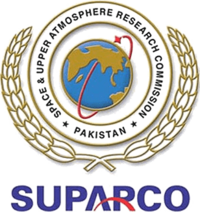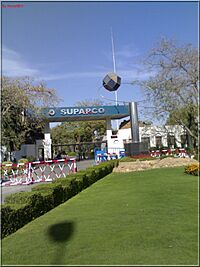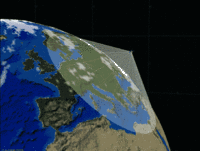SUPARCO facts for kids
| خلائی و بالائے فضائی تحقیقاتی مأموریہ | |
 |
|

|
|
| Agency overview | |
|---|---|
| Abbreviation | SUPARCO |
| Formed | Committee: 1961 - Karachi Commission: 1981 - Karachi |
| Type | Space agency |
| Jurisdiction | Government of Pakistan |
| Status | Active |
| Headquarters | Islamabad-45900, Pakistan |
|
Chairman
|
Muhammad Yusuf Khan |
| Key people |
|
| Primary spaceport | Sonmiani FTR |
| Owner | National Command Authority |
| Employees | Classified |
| Annual budget | (2022–23) |
The Space & Upper Atmosphere Research Commission, or SUPARCO, is Pakistan's national space agency. It's like Pakistan's version of NASA!
SUPARCO started in 1961 as a small group in Karachi. By 1981, it became an independent agency. Its first goal was to learn about rockets and the upper parts of Earth's atmosphere from the United States. This helped Pakistan create its own satellite program. In 1990, Pakistan successfully launched its first satellite from China. SUPARCO also helped with Pakistan's early rocket development.
Today, SUPARCO leads Pakistan's National Space Program (NSP). It manages how Pakistan's satellites work in orbit. It also helps run the Pakistan Space Activities Regulatory Board (PSARB). This board makes sure all space activities in Pakistan follow the rules.
Contents
- History of SUPARCO
- What SUPARCO Does
- Space Programs
- Facilities
- Working with Other Countries
- Leaders of SUPARCO
- See also
History of SUPARCO
How SUPARCO Started
In the 1950s, Pakistan's government didn't focus much on space or engineering. But things changed after the Soviet Union launched the first satellite, Sputnik 1, in 1957.
In 1961, during the time of the Apollo program in the US, a scientist named Abdus Salam saw a chance for Pakistan. The US space agency, NASA, needed scientific data from the upper atmosphere. They invited countries like India and Pakistan to join their studies. Pakistani engineers went to the US to learn about rockets.
Abdus Salam worked to get approval for a space commission in Pakistan. In 1961, the "Space and Upper Atmosphere Research Commission" was officially formed. It was the first space program in the Muslim world. Its goal was to learn about rocket engineering. France and the United States helped Pakistan start this mission. This made Pakistan the first country in South Asia to have a space program.
A special place called the Sonmiani Flight Test Range was built near Karachi. From there, SUPARCO launched its first rocket, Rehbar-I, on July 7, 1962. It went 80 miles (129 km) into space! The US supported this program. Until 1972, the US helped train Pakistani engineers at the Goddard Space Flight Center.
SUPARCO also set up ground stations in Karachi and Lahore in 1973. These stations helped with satellite navigation. Astronauts from the Apollo 17 mission even visited them.
Growing the Space Program
After 1972, the US stopped funding upper atmosphere research in Pakistan. Also, Pakistan focused more on its nuclear program. This meant less money for SUPARCO. Many engineers moved to the Pakistan Atomic Energy Commission.
In 1975, India launched its first satellite. This made SUPARCO push for Pakistan to have its own satellite program. In 1981, SUPARCO became an independent government agency. They started a project called PakSAT for communication satellites.
SUPARCO worked with the University of Surrey in England. This helped them build parts for satellites like UoSAT-1 and UO-11, which launched in 1984.
Pakistan's first satellite, Badr-1, was built by SUPARCO starting in 1983. It was launched by China in 1990. SUPARCO also worked with the British Rutherford Appleton Laboratory to develop the Badr-B satellite. It was launched by Russia in 2001.
Later, a decision to delay the PakSAT project in 1984 caused problems. Pakistan lost two important orbital slots for satellites. To get a good slot, SUPARCO bought an existing satellite, PakSAT-1, from Hughes Satellite Systems.
What SUPARCO Does
SUPARCO has many important jobs as Pakistan's national space agency. These include:
- Making Space Rules: They create national space policies and laws. This helps Pakistan follow international space agreements.
- Managing Programs: They plan and run the National Space Program. This includes space science, technology, and how space is used.
- Building Space Tools: They design, build, launch, and operate satellites. They also manage ground control stations and launch facilities.
- Keeping Records: They keep a list of all space objects launched by Pakistan. This information is shared with the United Nations.
- Helping Businesses: They encourage companies to use space technology for business.
- Working with Others: They work with other space organizations around the world. They also represent Pakistan in space discussions.
Space Programs
SUPARCO runs several exciting space programs.
Satellite Programs
SUPARCO has launched different types of satellites.
Badr Satellites
The Badr program includes Pakistan's first satellites.
| Satellite | Mass and weight | Satellite by type | Launch agency | Launch site | Status | Launch date | Remarks and notes |
|---|---|---|---|---|---|---|---|
| Badr-1 | 52 kg (115 lb) | Communications | CASC | Xichang in China | Inactive | 16 July 1990 | Built in coordinate with University of Surrey |
| Badr-B | 68.5 kg (151 lb) | Earth observation | Roscosmos | Baikonur in Kazakhstan | Inactive | 12 December 2001 | Built in coordination with Rutherford Laboratory. |
PakSAT Satellites
The PakSAT program is for Pakistan's communication satellites. These satellites help with TV, internet, and phone services.
| Satellite | Mass and weight | Satellite by type | Launch agency | Launch site | Status | Launch date | Remarks and notes |
|---|---|---|---|---|---|---|---|
| PakSAT-1E | 3,000 kg (6,600 lb) | GEO | Hughes | Cape Canaveral in United States | Inactive | 1 February 1996 | Built and owned by the Boeing. |
| PakSAT-1R | 5,515 kg (12,158 lb) | GEO | CASC | Xichang | Active | 11 August 2011 | Built and manufactured by China with Chinese funding |
| PakSAT-MM1 | 4,137 kg (9,121 lb) | GEO | Hughes | Cape Canaveral | Inactive | 5 March 2018 | Built and manufactured by Boeing |
| PakSAT-MM1R | 5,400 kg (11,900 lb) | GEO | CASC | Xichang | Active | 30 May 2024 | Built by CASC |
Remote Sensing Satellites
These satellites help us see and understand Earth from space. They are used for things like checking crops, watching weather, and managing disasters.
| Satellite | Mass and weight | Satellite by type | Launch agency | Launch site | Status | Launch date | Remarks and notes |
|---|---|---|---|---|---|---|---|
| PakTES-1A | 300 kg (660 lb) | LEO | CNSA | Jiuquan | Active | 9 July 2018 | Built and manufactured by SUPARCO |
| PRSS-1 | 300 kg (660 lb) | LEO | CNSA | Jiuquan | Active | 9 July 2018 | Jointly built and manufactured by China and Pakistan |
| PRSC-EO1 | - | LEO | CASC | Jiuquan | Active | 17 January 2025 | Built and manufactured by SUPARCO locally |
| PRSS-2 | - | LEO | CASC | Xichang | Active | 31 July 2025 | Jointly built and manufactured by China and Pakistan |
CubeSats
CubeSats are very small satellites, often the size of a shoebox. They are used for various research and educational purposes.
| Satellite | Mass and weight | Satellite by type | Launch agency | Launch site | Launch date | Remarks and notes |
|---|---|---|---|---|---|---|
| ICube-1 | 1.08 kg (2.4 lb) | 1U CubeSat | Kosmotras | Dombarovsky 370/13 | 21 November 2013 | Built by IST |
| ICUBE-Q | 9.0 kg (19.8 lb) | Lunar Orbiter | IST | Wenchang | 3 May 2024 | Jointly built by Institute of Space Technology, SUPARCO and Shanghai Jiao Tong University |
| PAUSAT-1 | 24 kg
(52.9 lb) |
16U
CubeSat |
SpaceX | Vandenberg Space Force Base | 14 January 2025 | Built by Air University Pakistan, launched from Space X Falcon 9 rocket onboard Transporter 12 mission. |
Rocket Programs
SUPARCO has also worked on rocket technology.
Sounding Rockets
Since 1961, SUPARCO developed rockets that go high into the atmosphere to collect data. The Rehbar-I rocket was one of these.
Military Rockets
SUPARCO helped design rocket engines for military projects like Hatf-I and Abdali. They also studied engines for the Shaheen program.
Space Science and Astronomy
SUPARCO promotes space science and astronomy in Pakistan.
Every year, SUPARCO organizes World Space Week. This event helps people learn more about Earth science. SUPARCO works with universities to research astronomy and astrophysics. The Institute of Space and Planetary Astrophysics (ISPA) at Karachi University does important research with SUPARCO.
SUPARCO also launches balloons to study the atmosphere. They measure things like the ozone layer up to 35 km high. This helps scientists understand weather and how the ozone layer changes.
SUPARCO has a special program to study the Moon. They observe its phases and share this information with the public.
The SUPARCO Astrophysics program focuses on understanding the universe. It researches topics like quantum mechanics, dark matter, and galaxies. This program also aims to teach more people about physics and mathematics. It works with international space agencies and celebrates astronomy events.
Space Weather Monitoring
SUPARCO watches space weather. Space weather is caused by the Sun and can affect satellites and communication on Earth.
Pakistan relies more and more on satellites. So, SUPARCO created the Pakistan Space Weather Center. This center uses special tools to watch space weather in real time. It shares important information with users in Pakistan.
SUPARCO also studies Earth's magnetic field. They have observatories in Sonmiani and Karachi. This helps them understand how the magnetic field changes and how to protect against space weather hazards. They publish reports on how solar flares and magnetic storms affect Earth.
SUPARCO is key to Pakistan's satellite navigation. This is like the GPS you use on your phone, but for many different uses.
They have systems that send correction signals to users. This helps make navigation more accurate for planes, ships, and land vehicles.
SUPARCO also monitors satellite navigation signals from stations across Pakistan. They work with other organizations to improve navigation systems.
International COSPAS-SARSAT Programme

Pakistan is part of a global program called International Cospas-Sarsat Programme. This program uses satellites to help with search and rescue missions. If someone is in distress, their signal can be picked up by satellites.
In 1990, Pakistan joined this program. SUPARCO's mission control center in Karachi helps send distress alerts to rescue teams in the country.
Remote Sensing Program
SUPARCO was one of the first to use Remote Sensing and GIS (Geographic Information Systems) in Pakistan. These technologies use satellite images and data to help with many things.
They provide solutions for agriculture, managing forests, disaster relief, water resources, and city planning. They also study climate change and pollution. SUPARCO has special labs and centers for this work.
Other Scientific Programs
- Scientific space research
- Geographic Information Systems
- Natural Resource Surveying
- Environmental monitoring
- Collecting data for weather studies
- Developing ground systems for navigation
- Building research and production facilities for space
Facilities
SUPARCO has its main office in Islamabad. It also has many important facilities across Pakistan.
Ground Stations
These stations help SUPARCO communicate with and control satellites.
| Facility Name | Location | Description | Sources |
|---|---|---|---|
| Satellite Ground Station (SGS) | Islamabad | Used for acquiring satellite imagery from a number of Pakistani and foreign satellites | |
| Satellite Ground Station (SGS) | Karachi | — | |
| Pakistan Mission Control Center (PMCC) | Karachi | Ground segment for the International Cospas-Sarsat Programme |
Space Applications Centres
These centers use space technology to solve problems on Earth.
| Facility Name | Location | Description | Sources |
|---|---|---|---|
| Space Application and Research Centre Islamabad (SPARC-I) | Islamabad | Space applications centre | |
| Space Application and Research Centre Karachi (SPARC-K) | Karachi | Space applications centre | |
| Space Application Center for Response in Emergency and Disasters (SACRED) | Islamabad | Provides space-based technical support during natural disasters | |
| National Centre of GIS & Space Applications (NCGSA) | Islamabad | A center with seven advanced research labs in different universities. |
Research and Development Centres
These centers are where new satellites and space technologies are designed and built.
| Facility Name | Location | Description | Sources |
|---|---|---|---|
| Satellite Research and Development Complex (SRDC-L) | Lahore | Designs and develops satellites | |
| Satellite Research and Development Complex (SRDC-K) | Karachi | Designs and develops satellites |
Space Ports
These are places where rockets and satellites can be launched.
| Facility Name | Location | Description | Sources |
|---|---|---|---|
| Sonmiani FTR | Sonmiani | It has launched sounding rockets in the past. |
Education and Training
SUPARCO also helps train future space scientists and engineers.
| Facility Name | Location | Description |
|---|---|---|
| SUPARCO Managed | ||
| Institute of Space Technology | Islamabad | This is a university that offers degrees in Aerospace Engineering, Communication systems, Materials Engineering, Space Sciences, and Mechanical Engineering. |
| SUPARCO Institute of Technical Training (SITT) | Karachi | This facility offers diploma programs in Mechanical and Electronics Technology. |
| Others | ||
| Institute of Space and Planetary Astrophysics (ISPA) | Karachi University | This is an old and important astronomy facility. It does research in space and planetary science. It has a powerful telescope. |
| Department of Space Science | University of Punjab | This department researches solar physics, plasma physics, astrophysics, remote sensing, and planetary sciences. It has a small astronomical observatory. |
| National Centre for Remote Sensing and Geo-informatics (NCRG) | Institute of Space Technology, Karachi | A national center for excellence in remote sensing. |
Working with Other Countries
SUPARCO believes in working with other countries in space. It is a member of many international space groups and the United Nations. This helps them share information, work on projects, and transfer technology. Pakistan has signed many agreements with other countries for space activities.
Inter-Islamic Network on Space Sciences and Technology
This network was started in 1987 by the Organisation of Islamic Cooperation (OIC). SUPARCO hosted the first meeting in Karachi. The head office of this network is at SUPARCO. It has 17 member countries and organizes conferences and training related to space science.
China
China and Pakistan have a strong partnership in space. In 2006, they agreed to do joint research and launch Earth-weather satellites. In 2007, they signed an agreement to work more closely in space science and technology. Their cooperation includes climate science, clean energy, and Earth sciences.
In May 2024, Pakistan sent its first lunar orbiter, ICUBE-Q, to the Moon with China's Chang'e 6 mission. SUPARCO will also launch a lunar rover with China's Chang'e 8 mission.
United Arab Emirates
In 2019, SUPARCO participated in the Global Space Congress in Abu Dhabi. They showed their satellite projects there.
Turkey
In 2006, Turkey showed interest in working with Pakistan on space projects. They signed agreements to develop satellite technology together.
Leaders of SUPARCO
Here are some of the people who have led SUPARCO:
| # | Name | Term Started | Term Ended | Alma Mater | Field(s) | Educational Background |
|---|---|---|---|---|---|---|
| 1. | Dr Abdus Salam | 1961 | 1967 | Imperial College, London
University of the Punjab, Lahore |
Theoretical Physics | Doctor of Philosophy (PhD) |
| 2. | Dr Ishrat Hussain Usmani (Co-Chairman) | 1961 | 1967 | Imperial College, London | ICS | PhD |
| 3. | Air Cdre. Władysław Turowicz | 1967 | 1969 | Warsaw University | Aeronautical Engineering | Graduate |
| 4. | Air Cdre. K. M. Ahmad | 1969 | 1973 | Pakistan Air Force Academy | Aeronautical Engineering | Graduate |
| 5. | Dr Salim Mehmud | 1980 | 1989 | Oak Ridge Institute for Science and Education and Oak Ridge National Laboratory | Nuclear Engineering, Electrical engineering, Physics, Mathematics, Electronics engineering | Masters |
| 6. | Dr M. Shafi Ahmad | 1989 | 1990 | University of London | Astronomy | PhD |
| 7. | Engr. Sikandar Zaman | 1990 | 1997 | University of Michigan | Mechanical / Aeronautical Engineering | Masters |
| 8. | Dr Abdul Majid | 1997 | 2001 | University of Wales | Astrophysics | PhD |
| 9. | Major General Raza Hussain | 2001 | 2010 | Pakistan Army Corps of Electrical and Mechanical Engineers | Electrical Engineering | BS |
| 10. | Major General Ahmed Bilal | 2010 | 2016 | Pakistan Army Corps of Signals Engineering | Computer Engineering | Master of Science (MS) |
| 11. | Major General Qaiser Anees Khurram | 2016 | 2018 | Pakistan Army Corps of Electrical and Mechanical Engineers | Mechanical Engineering | BS |
| 12. | Major General Amer Nadeem | 2018 | 2023 | Pakistan Army Corps of Electrical and Mechanical Engineers | Aeronautical Engineering | BS |
| 13. | Muhammad Yusuf Khan | 2023 | 2025 | University of Peshawar | Master of Science | MS |
See also
- List of government space agencies
- SUPARCO's spaceflight missions and tests
- SUPARCO Space Programme 2040
- Jinnah Antarctic Station

